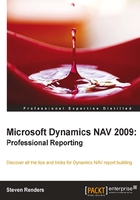
What this book covers
Chapter 1, What's Available in the Box?, gives an overview of the types of reports available in the application, where to find them, and how to use them. You can create your custom reports without the need for a developer or report designer. This can be done by making use of dimensions, analysis views, and account schedules and so on. It's important to know what's already available for free in the application, before you start spending time, money, and resources on developing custom reports.
Chapter 2, Creating a Classic Report, explains the classic layout, how to create it, and all the capabilities of the good old classic report designer. The creation aspect of the classic report will be kept to a minimum, with more focus on new reporting possibilities of the Role Tailored Client. You will need this information to design reports for the Role Tailored Client, as development of reports starts with a classic report and knowledge about the classic designer is still required.
Chapter 3, Creating a Role Tailored Client Report, dives into the Role Tailored Report designer, or the RDLC report layout as it is called. It starts with an introduction to Visual Studio, its different flavors (versions), the toolbars, the environment, and useful shortcuts. It will explain the different ways to create a report from scratch using the Create Layout suggestion feature. You will see different kinds of problems you may encounter when developing reports for the Role Tailored Client and how to troubleshoot them.
Chapter 4, Visualization Methods, explains that creating reports is not just extracting and formatting data from the database and dropping it onto a layout. The way you visualize the information is equally important. The report will stand or fall depending on the way the information is rendered and presented to the user. That's why a big portion on the chapter will be about data visualization techniques and how to apply them in RDLC.
Chapter 5, Developing Specific Reports, explains how the RDLC report layout for documents, such as a sales invoice, is full of workarounds. We will explore it in detail with the most important workarounds, how and why they are required, and explore some alternative solutions. Creating dashboards and top x reports are also covered in this chapter.
Chapter 6, Other Reporting Tools and Business Intelligence, explains the database behind the Dynamics NAV application. How can you create an ER model? How are the tables related to each other? This chapter will address all these questions. The chapter then dives into SQL Server Reporting Services and explains how you can create an SSRS report. Other BI tools from the Microsoft stack, like for example PowerPivot, Excel Data Mining and Business Analytics, are also covered in this chapter. The purpose is to get a good overview on the other tools that are out there and the added value they have to offer on top of a Dynamics NAV database.
Chapter 7, A View to the Future, shows the future panorama of reporting in Dynamics NAV. Besides the Dynamics NAV application, the other BI applications are also evolving and becoming more integrated. This chapter will try to give you an overview on what will or might happen and the kind of impact or added value it might offer for Dynamics NAV.